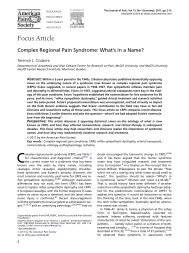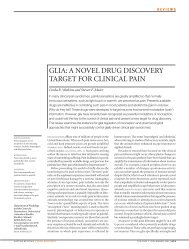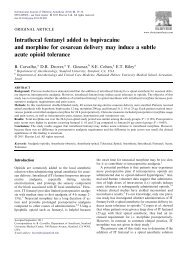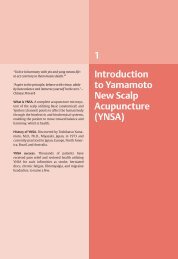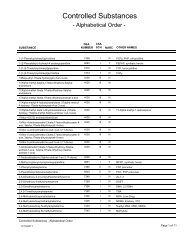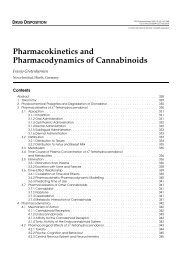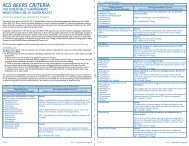1) Vitamin D For Chronic Pain - Pain Treatment Topics.org
1) Vitamin D For Chronic Pain - Pain Treatment Topics.org
1) Vitamin D For Chronic Pain - Pain Treatment Topics.org
You also want an ePaper? Increase the reach of your titles
YUMPU automatically turns print PDFs into web optimized ePapers that Google loves.
<strong>Vitamin</strong> D for <strong>Chronic</strong> <strong>Pain</strong><br />
TABLE 2: DEFINING ADEQUATE<br />
25(OH)D CONCENTRATIONS<br />
25(OH)D Concentrations<br />
Major Metabolite of <strong>Vitamin</strong> D from D 2 or D 3<br />
Deficient 150 ng/mL<br />
In some literature 25(OH)D is expressed as nmol/L.<br />
The conversion formula is: 1 ng/mL = 2.5 nmol/L<br />
or 1 nmol/L = 0.4 ng/mL.<br />
References: Heaney 39 ; Heaney et al 42 ; Holick 14 ; Reginster et<br />
al 41 ; Tavera-Mendoza and White 18 ; Vieth 24<br />
in their genetic makeup (poly-morphism)<br />
and activity, which may account for<br />
varying individual responses to vitamin D<br />
therapy. 32,33<br />
The discovery of vitamin D receptors<br />
in many tissues besides intestine and<br />
bone—including heart, pancreas, breast,<br />
prostate, lymphocytes, and other<br />
tissues—implies that vitamin D supplementation<br />
might have applications for<br />
treating a number of disorders. These<br />
include autoimmune diseases, diabetes,<br />
cardiovascular disease, psoriasis, hypoparathyroidism,<br />
renal osteodystrophy,<br />
and possibly leukemia and cancers of the<br />
breast, prostate, or colon. 1-3,20,34-37 Research<br />
is ongoing in these areas.<br />
If vitamin D production or intake is<br />
diminished, reabsorption of vitamin D<br />
from tissue-storage reservoirs can<br />
sustain conversion to 25(OH)D and the<br />
1,25(OH) 2 D metabolite for several<br />
months. However, an abundant supply of<br />
vitamin D during certain times, such as<br />
from summer sun exposure, does not<br />
deter its complete depletion during<br />
periods of lean intake, such as during<br />
winter months. 19<br />
Numerous individual factors may affect<br />
the status of vitamin D and its metabolites<br />
in the body. Synthesis of vitamin D 3 in the<br />
skin in reaction to UVB exposure is a selflimiting<br />
reaction that achieves equilibrium<br />
within 20 to 25 minutes of exposure<br />
to strong sunlight in persons with white<br />
skin, with no net increase in D 3 production<br />
after that. 19 Persons with darker skin<br />
require longer sun exposure, but the total<br />
yield in D 3 is the same. Age is another<br />
limiting factor, and it is more difficult for<br />
older persons to acquire adequate vitamin<br />
D from UVB radiation. 21,28<br />
Adequate 25(OH)D Concentration.<br />
Most researchers agree that a minimum<br />
25(OH)D serum level of about 30 ng/mL<br />
or more is necessary for favorable calcium<br />
absorption and good health. 14,38-41 Optimal<br />
25(OH)D concentrations are considered<br />
to range from 30 ng/mL to 50 ng/mL (see<br />
Table 2). 20,35,36,42-44<br />
Most definitions of deficiency stress<br />
that circulating 25(OH)D concentrations<br />
of 100 ng/mL as possibly toxic, but this<br />
could be overly conservative and reported<br />
reference ranges are not always consistent<br />
from one laboratory to another.<br />
General Prevalence of “D-ficiency.”<br />
There is a growing consensus that vitamin<br />
D inadequacies in the general population—or<br />
what Holick [2004a] 112 has<br />
broadly labeled “D-ficiency”—are much<br />
more common and severe than might be<br />
imagined. This has been extensively<br />
studied and, according to the research<br />
evidence, it may be assumed in almost any<br />
clinical practice that at least 50% of<br />
patients will have 25(OH)D concentrations<br />
below 30 ng/mL, the lower limit of<br />
the optimal range. In many instances, the<br />
percentage of patients with vitamin D<br />
insufficiency will be much greater, and a<br />
significant proportion of them may have<br />
more serious deficiencies of



